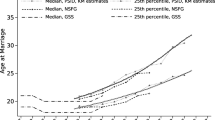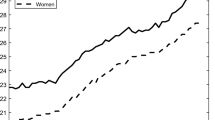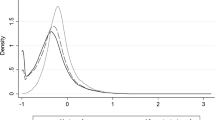Abstract
The growing economic resemblance of spouses has contributed to rising inequality by increasing the number of couples in which there are two high- or two low-earning partners. The dominant explanation for this trend is increased assortative mating. Previous research has primarily relied on cross-sectional data and thus has been unable to disentangle changes in assortative mating from changes in the division of spouses’ paid labor—a potentially key mechanism given the dramatic rise in wives’ labor supply. We use data from the Panel Study of Income Dynamics (PSID) to decompose the increase in the correlation between spouses’ earnings and its contribution to inequality between 1970 and 2013 into parts due to (a) changes in assortative mating, and (b) changes in the division of paid labor. Contrary to what has often been assumed, the rise of economic homogamy and its contribution to inequality is largely attributable to changes in the division of paid labor rather than changes in sorting on earnings or earnings potential. Our findings indicate that the rise of economic homogamy cannot be explained by hypotheses centered on meeting and matching opportunities, and they show where in this process inequality is generated and where it is not.






Similar content being viewed by others
Notes
We do not use the 1950 census because only one person in the household was asked about their earnings, and thus spouses’ earnings correlations cannot be calculated.
Defining sorting as the association between spouses’ FTFY earnings potential as predicted by characteristics in a given year assumes perfect foresight of changes that affect future earnings, such as changes in occupation or educational attainment. To the extent that individuals do not foresee these changes, we will overestimate the contribution of sorting on earnings potential. Sensitivity tests show that estimating predicted earnings based only on characteristics at the time of marriage yields results very similar to those presented here.
Because the correlation between spouses’ earnings has been stable since approximately 1990 but inequality has risen, estimates of the contribution of economic homogamy to inequality are larger in earlier periods.
Supplementary analyses suggest that the correlation between spouses’ earnings potential did not increase because the correlation between spouses’ years of schooling declined over this period in the PSID. The declining correlation between spouses’ years of schooling is inconsistent with many assortative mating studies, which have reported an increase in educational homogamy (see Schwartz 2013 for a review). However, the correlation coefficient is affected by changes in the marginal distributions of spouses’ education. Log-linear models controlling for shifts in the marginal distributions of education using the PSID produce increases in educational homogamy similar to those estimated by Schwartz and Mare (2005). It is debatable whether the best way to measure the effects of educational assortative mating on earnings homogamy and inequality is to control for the marginal distributions (Breen and Salazar 2011). However, resolving this issue is beyond the scope of this article.
References
Bailey, M. J. (2006). More power to the pill: The impact of contraceptive freedom on women's life cycle labor supply. Quarterly Journal of Economics, 121, 289–320.
Becker, G. S. (1974). A theory of marriage. In T. W. Schultz (Ed.), Economics of the family: Marriage, children, and human capital (pp. 299–344). Chicago, IL: University of Chicago Press (for the National Bureau of Economic Research).
Blackburn, M. L., & Bloom, D. E. (1995). Changes in the structure of family income inequality in the United States and other industrial nations during the 1980s. In S. W. Polacheck (Ed.), Research in labor economics (pp. 141–170). Greenwich, CT: JAI Press.
Blair-Loy, M. (2003). Competing devotions: Career and family among women executives. Cambridge, MA: Harvard University Press.
Blau, F. D., Brummund, P., & Liu, A. Y.-H. (2013). Trends in occupational segregation by gender 1970–2009: Adjusting for the impact of changes in the occupational coding system. Demography, 50, 471–492.
Blossfeld, H.-P. (2009). Educational assortative marriage in comparative perspective. Annual Review of Sociology, 35, 513–530.
Blossfeld, H.-P., & Timm, A. (Eds.) (2003). Who marries whom? Educational systems as marriage markets in modern societies. Dordrecht, The Netherlands: Kluwer Academic.
Breen, R., & Andersen, S. H. (2012). Educational assortative mating and income inequality in Denmark. Demography, 49, 867–887.
Breen, R., & Salazar, L. (2010). Has increased women’s educational attainment led to greater earnings inequality in the United Kingdom? A multivariate decomposition analysis. European Sociological Review, 26, 143–157.
Breen, R., & Salazar, L. (2011). Educational assortative mating and earnings inequality in the United States. American Journal of Sociology, 117, 808–843.
Burkhauser, R. V., Butler, J. S., Feng, S., & Houtenville, A. J. (2004). Long term trends in earnings inequality: What the CPS can tell us. Economics Letters, 82, 295–299.
Buss, D. M., Shackelford, T. K., Kirkpatrick, L. A., & Larsen, R. J. (2001). A half century of mate preferences: The cultural evolution of values. Journal of Marriage and Family, 63, 491–503.
Cancian, M., Danziger, S., & Gottschalk, P. (1993). Working wives and family income inequality among married couples. In S. Danziger & P. Gottschalk (Eds.), Uneven tides: Rising inequality in America (pp. 195–221). New York, NY: Russell Sage Foundation.
Cancian, M., & Reed, D. (1998). Assessing the effects of wives’ earnings on family income inequality. Review of Economics and Statistics, 80, 73–79.
Cancian, M., & Reed, D. (1999). The impact of wives’ earnings on income inequality: Issues and estimates. Demography, 36, 173–184.
Cherlin, A. J. (2004). The deinstitutionalization of American marriage. Journal of Marriage and Family, 66, 848–861.
Cotter, D. A., Hermsen, J. M., & Vanneman, R. (2001). Women’s work and working women: The demand for female labor. Gender & Society, 15, 429–452.
Dynan, K., Elmendorf, D., & Sichel, D. (2012). The evolution of household income volatility. BE Journal of Economic Analysis & Policy, 12(2), 1–40. doi:10.1515/1935-1682.3347
Eika, L., Mogstad, M., & Zafar, B. (2014). Educational assortative mating and household income inequality (NBER Working Paper No. 2027). Cambridge, MA: National Bureau of Economic Research.
Elder, G. H. (1999). Children of the Great Depression: Social change in life experience. Boulder, CO: Westview Press.
England, P. (2010). The gender revolution: Uneven and stalled. Gender & Society, 24, 149–166.
Fernández, R., Guner, N., & Knowles, J. (2005). Love and money: A theoretical and empirical analysis of household sorting and inequality. Quarterly Journal of Economics, 120, 273–344.
Fernández, R., & Rogerson, R. (2001). Sorting and long-run inequality. Quarterly Journal of Economics, 116, 1305–1341.
Gerson, K. (1985). Hard choices: How women decide about work, career, and motherhood. Berkeley: University of California Press.
Gerson, K. (2010). The unfinished revolution: How a new generation is reshaping family, work, and gender in America. Oxford, UK: Oxford University Press.
Goldin, C. (2006). The quiet revolution that transformed women’s employment, education, and family. American Economic Review, 96, 1–21.
Goldin, C. (2014). A grand gender convergence: Its last chapter. American Economic Review, 104, 1091–1119.
Goldin, C., & Katz, L. F. (2002). The power of the pill: Oral contraceptives and women’s career and marriage decisions. Journal of Political Economy, 110, 730–770.
Goldscheider, F., Bernhardt, E., & Lappegård, T. (2015). The gender revolution: A framework for understanding changing family and demographic behavior. Population and Development Review, 41, 207–239.
Greenwood, J., Guner, N., Kocharkov, G., & Santos, C. (2014). Marry your like: Assortative mating and income inequality. American Economic Review, 104, 348–353.
Harmenberg, K. (2014). A note: The effect of assortative mating on income inequality. Unpublished manuscript, Institute for International Economic Studies, Stockholm University, Stockholm, Sweden.
Hryshko, D., Juhn, C., & McCue, K. (2014). Trends in earnings inequality and earnings instability among US couples: How important is assortative matching? (IZA Discussion Paper No. 8729). Bonn, Germany: Institute for the Study of Labor.
Hyslop, D. R. (2001). Rising U.S. earnings inequality and family labor supply: The covariance structure of intrafamily earnings. American Economic Review, 91, 755–777.
Kalmijn, M. (1998). Intermarriage and homogamy: Causes, patterns, trends. Annual Review of Sociology, 24, 395–421.
Kitagawa, E. M. (1955). Components of a difference between two rates. Journal of the American Statistical Association, 50, 1168–1194.
Kremer, M. (1997). How much does sorting increase inequality? Quarterly Journal of Economics, 112, 115–139.
McCall, L., & Percheski, C. (2010). Income inequality: New trends and research directions. Annual Review of Sociology, 36, 329–347.
McLanahan, S., & Percheski, C. (2008). Family structure and the reproduction of inequalities. Annual Review of Sociology, 34, 257–276.
Mulligan, C. B., & Rubinstein, Y. (2008). Selection, investment, and women’s relative wages over time. Quarterly Journal of Economics, 123, 1061–1110.
Musick, K., Gonalons-Pons, P., Schwartz, C., & Griffin, L. (2016, August). Trends in couples’ work patterns after childbirth: Evidence from the SIPP and administrative earnings. Presented at the annual meeting of the American Sociological Association, Seattle, WA.
Oppenheimer, V. K. (1988). A theory of marriage timing. American Journal of Sociology, 94, 563–591.
Oppenheimer, V. K. (1994). Women’s rising employment and the future of the family in industrial societies. Population and Development Review, 20, 293–342.
Oppenheimer, V. K. (1997). Women’s employment and the gain to marriage: The specialization and trading model. Annual Review of Sociology, 23, 431–453.
Oppenheimer, V. K., Kalmijn, M., & Nelson, L. (1997). Men’s career development and marriage timing during a period of rising inequality. Demography, 34, 311–330.
Pencavel, J. (1998). Assortative mating by schooling and the work behavior of wives and husbands. American Economic Review, 88, 326–329.
Percheski, C. (2008). Opting out? Cohort differences in professional women’s employment rates from 1960 to 2005. American Sociological Review, 73, 497–517.
Pestel, N. (2014). Beyond inequality accounting: Marital sorting and couple labor supply (IZA Discussion Paper No. 8482). Bonn, Germany: Institute for the Study of Labor.
Reardon, S. F., & Bischoff, K. (2011). Income inequality and income segregation. American Journal of Sociology, 116, 1092–1153.
Reed, D., & Cancian, M. (2012). Rising family income inequality: The importance of sorting. Journal of Income Distribution, 21(2), 3–14.
Ruggles, S. (2015). Patriarchy, power, and pay: The transformation of American families, 1800–2015. Demography, 52, 1797–1823.
Ruggles, S., Alexander, J. T., Genadek, K., Goeken, R., Schroeder, M. B., & Sobek, M. (2010). Integrated Public Use Microdata Series: Version 5.0 [Machine-readable database]. Minneapolis: University of Minnesota.
Ryder, N. B. (1965). The cohort as a concept in the study of social change. American Sociological Review, 30, 843–861.
Schwartz, C. R. (2010). Earnings inequality and the changing association between spouses’ earnings. American Journal of Sociology, 115, 1524–1557.
Schwartz, C. R. (2013). Trends and variation in assortative mating: Causes and consequences. Annual Review of Sociology, 39, 451–470.
Schwartz, C. R., & Mare, R. D. (2005). Trends in educational assortative marriage from 1940 to 2003. Demography, 42, 621–646.
Stone, P. (2007). Opting out? Why women really quit careers and head home. Berkeley: University of California Press.
Sweeney, M. M., & Cancian, M. (2004). The changing importance of white women’s economic prospects for assortative mating. Journal of Marriage and Family, 66, 1015–1028.
Western, B., Bloome, D., & Percheski, C. (2008). Inequality among American families with children, 1975 to 2005. American Sociological Review, 73, 903–920.
Xie, Y., Raymo, J. M., Goyette, K., & Thornton, A. (2003). Economic potential and entry into marriage and cohabitation. Demography, 40, 351–367.
Acknowledgments
This research was carried out using the facilities of the Center for Demography and Ecology at the University of Wisconsin–Madison (R24 HD047873) and was prepared for presentation at the 2014 annual meeting of the Population Association of America in Boston. An earlier version of this article was presented at the 2013 International Sociological Association Research Committee on Social Stratification and Mobility (RC28) in Trento, Italy. We are grateful to Russell Dimond, Greg Duncan, Christopher McKelvey, Robert Pollak, and the participants of seminars and lectures at Duke University; New York University; University of California, Los Angeles; Washington University; and University of Wisconsin–Madison for helpful comments and advice.
Author information
Authors and Affiliations
Corresponding author
Electronic supplementary material
ESM 1
(PDF 590 KB)
Appendix
Appendix
Table 3
Rights and permissions
About this article
Cite this article
Gonalons-Pons, P., Schwartz, C.R. Trends in Economic Homogamy: Changes in Assortative Mating or the Division of Labor in Marriage?. Demography 54, 985–1005 (2017). https://doi.org/10.1007/s13524-017-0576-0
Published:
Issue Date:
DOI: https://doi.org/10.1007/s13524-017-0576-0




